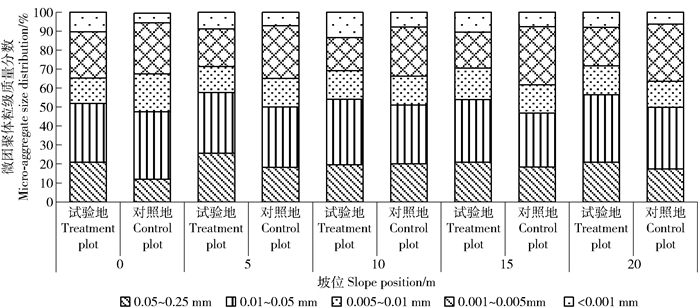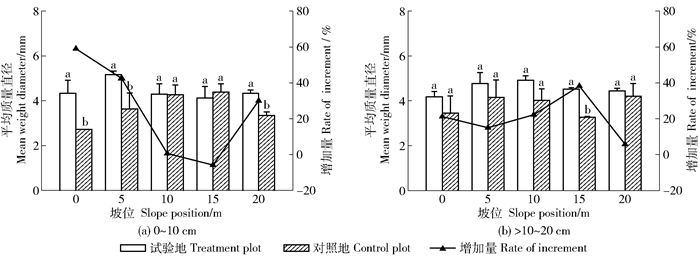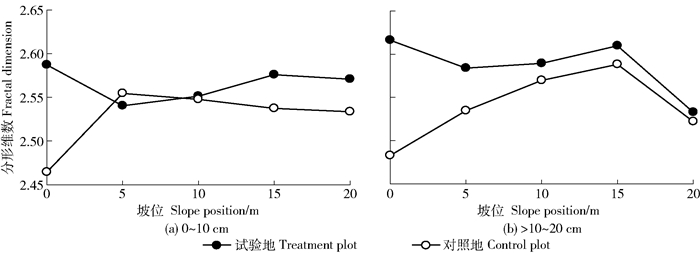2. 四川农业大学林学院, 610000, 成都;
3. 西南科技大学环境与资源学院, 621000, 四川绵阳
中国水土保持科学  2020, Vol. 18 2020, Vol. 18  Issue (2): 69-76. DOI: 10.16843/j.sswc.2020.02.009 Issue (2): 69-76. DOI: 10.16843/j.sswc.2020.02.009 |
土壤微团聚体是由有机无机复合胶体经过多次聚合而形成的,在土体内以不同粒级组合的形式存在,不仅是有机碳、氮、磷等养分储存的载体,也是良好土壤结构体的物质基础[1]。根系作为植物和土壤接触的主要组织,与土壤物理、生物和化学性质的变化密切相关,对土壤微团聚体的形成和稳定产生直接或间接影响[2]。我国大多数紫色土坡地已经被开垦为耕地[3],受强烈的人为活动影响,紫色土区是我国仅次于黄土区土壤侵蚀最严重的地区[4]。因此,研究紫色土区植物根系对土壤微团聚体组成的影响对于正确认识该地区植物根系的水土保持作用具有重要意义。
近年来国内外研究主要集中于微团聚体的形成机制及影响因素等方面。微团聚体是通过黏粒、SOM以及阳离子的进一步黏结形成的[5],耕作措施[6]、土壤类型[7]、植物根系[8]等对土壤微团聚体的形成产生重要影响。Krause等[7]发现黏土有利于微团聚体的形成和稳定,而低黏土含量导致土壤微团聚体内有机碳富集。代文才等[9]发现紫色丘陵区林地、果园和花椒地的土壤微团聚体组成结构比农耕地更加稳定。众多研究表明植物根系能有效提高土壤的物理性质,改善土壤微团聚体特征。小麦是我国第3大粮食作物,其根系为密集的须根,但生命周期较短,对土壤微团聚体结构特征的影响与乔木、灌草等植被不同。目前,关于乔灌草的根系对无人为扰动的土壤微团聚体的影响研究较多,而关于农作物根系对坡耕地内不同坡位土壤微团聚体特征的影响报道尚少;因此,笔者以紫色土区种植典型粮食作物(小麦)的坡耕地为研究对象,分析种植小麦对坡地不同坡位土壤微团聚体组成及稳定性的影响,旨在为研究紫色土区坡地农作物根系的水土保持作用提供理论依据。
1 研究区概况本研究在四川省遂宁水土保持试验站内(E 105°28′37″,N 30°21′51″)进行,该站地处川中盆地中部,属涪江水系的一级支流琼江流域,平均海拔约420m。该区属亚热带湿润季风气候,年平均气温为18℃,年均降雨量933mm左右,集中在5—9月,年均蒸发量897mm,平均无霜期296d。土壤母质为侏罗系遂宁组岩层发育而成的紫色土,主要是砂、页、泥岩风化形成的幼年土,土壤pH呈中性到微碱性,结构性差,抗冲刷和抗蚀能力较弱。研究区属于紫色土主要分布区域之一,坡耕地分布广泛,但是由于坡度大、可耕地面积少、导致耕作侵蚀显著。
2 材料与方法 2.1 样品采集与处理2017年11月在试验站内选取2块典型样地(5m×20m),其中一块样地长期按当地常见的种植模式种植小麦(试验地),行距为20cm,株距为15cm,另一块裸地作为对照地。待小麦成熟收获后(2018年4月29日),直接齐根割掉地上部分进行本研究的相关实验。在2块样地分别布设2条平行的取样剖面线,沿剖面线从坡顶至坡脚每隔5m在小麦根系分布范围内布设一个采样点(距坡顶0、5、10、15和20m)。剖面法采集采样点0~10和>10~20cm土层原状土,共40个样品。带回实验室后将土壤样本中的大颗粒物沿自然结构轻轻剥离成直径约10mm的小土块,并去除样本内的生物残骸、根系和石块等杂质。取自然风干且 < 2mm过筛土壤采用吸管法测定各粒级微团聚体质量分数[10]。同时采用环刀和土钻在采样点附近取样,测定土壤理化性质参数[10](表 1)。
| 表 1 供试土壤理化性质参数表 Tab. 1 Soil physical and chemical properties parameter list |
| $ \text{MWD}=\sum\limits_{i=1}^{n}{{{{\bar{x}}}_{i}}}{{w}_{i}}。$ | (1) |
式中:MWD为土壤微团聚体平均质量直径(mean weight diameter);
| $ \text{MWSSA}=\sum\limits_{i=1}^{n}{6}{{w}_{i}}/{{\rho }_{i}}{{{\bar{x}}}_{i}}。$ | (2) |
式中:MWSSA为土壤微团聚体平均质量比表面积(mean weight soil surface area),假设土壤微团聚体近似为球体,同时忽略各粒级间土壤密度的差异,则ρi=ρn=2.65g/cm3。
| $ (3-D)\lg \left( \frac{{{{\bar{x}}}_{i}}}{{{{\bar{x}}}_{\max }}} \right)=\lg \left[ \frac{{{W}_{\left( \delta <{{{\bar{x}}}_{i}} \right)}}}{{{W}_{0}}} \right]。$ | (3) |
式中:D为土壤微团聚体分形维数(fractal dimension)[11];
对式(3)进行回归拟合分析,可得D值。
试验所得数据采用SPSS 20.0软件进行方差分析及相关分析。图表采用Excel 2010和SigmaPlot 10.0软件绘制。
3 结果与分析 3.1 土壤微团聚体粒径组成及空间分布变化试验地和对照地的土壤微团聚体各粒级质量分数之间存在显著差异(表 2)。整体上看,所有处理的0.01~0.05mm粒级微团聚体平均质量分数为32.51%(25.22%~38.08%),显著高于其他粒级;其次,0.001~0.005和0.05~0.25mm粒级微团聚体为次优势粒级,< 0.001mm粒级微团聚体质量分数最小,平均仅为7.98%(2.32%~14.08%)。所有处理各粒级微团聚体平均质量分数大小顺序为w0.01~0.05>w0.001~0.005>w0.05~0.25>w0.005~0.01>w< 0.001。
| 表 2 不同土层2种处理下各粒级土壤微团聚体质量分数 Tab. 2 Mass percentages of different particle size of micro-aggregates for two treatments in different soil depth |
由表 2可知,整个坡面同一土层试验地和对照地之间土壤微团聚体各粒级质量分数存在差异。在0~10cm以及>10~20cm土层中,试验地的0.05~0.25mm粒级微团聚体平均质量分数显著高于对照地(P < 0.05),而0.001~0.005mm粒级相反。同时在>10~20cm土层中,< 0.001mm粒级微团聚体平均质量分数相比于对照地显著增加了44.95%,0.01~0.05mm、0.005~0.01mm粒级微团聚体质量分数与对照地差异不显著(P>0.05)。
不同坡位土壤微团聚体的组成有较大差异(图 1)。在0m处试验地的0.05~0.25mm、< 0.001mm粒级微团聚体质量分数分别比对照地增加了76.59%、105.03%;其他粒级质量分数低于对照地。在5m坡位处,与对照地相比,0.05~0.25mm粒级微团聚体质量分数显著增加(P < 0.05),而0.001~0.005mm粒级质量分数则相反;在10m、15m、20m坡位处,试验地的0.001~0.005mm粒级微团聚体质量分数比对照地分别显著减少了32.94%、38.29%、32.28%。其余粒级质量分数均无显著变化。总体来看,试验地各坡位大粒级微团聚体(0.01~0.25mm)质量分数均高于对照地。

|
图 1 土壤微团聚体组成的坡面分布差异 Fig. 1 Slope distribution of soil micro-aggregates compositions |
土壤微团聚体MWD越大,表明土壤微团聚体结构越稳定,抗蚀能力越强。在0~10cm土层中,试验地的MWD在0m、5m、20m坡位处比对照地分别显著增加了59.03%、42.46%和29.99%(图 2(a))。在>10~20cm土层中,试验地15m坡位处的MWD相比于对照地增加了38.23%(图 2(b)),其余坡位无显著性差异。表明试验地表层(0~10cm)土壤结构稳定性明显变化发生在上坡(0~5m)和坡底(20m)处,其余坡位变化不明显。

|
不同小写字母表示不同处理在P < 0.1水平上差异显著。Different lowercase letters indicate that differences among with different treatments are significant at P < 0.1 level. 图 2 各土层不同坡位土壤微团聚体平均质量直径 Fig. 2 Mean weight diameter of soil micro-aggregates from different soil depth at different slope positions |
土壤微团聚体MWSSA值越小,表明土壤分散性越弱[9]。如表 3所示,在0~10cm土层中,5m、10m坡位处试验地的土壤微团聚体MWSSA比对照地分别降低了11.97%、20.92%;而在0m、15m坡位,MWSSA高于对照地。在>10~20cm土层中,试验地在10、15和20m坡位的MWSSA均低于对照地;而在0m坡位处,MWSSA比对照地增加了24.79%。整体来看,试验地的MWSSA在各土层不同坡位变化系数(CV)分别为13.08%和9.42%,表明种植小麦后坡位对土壤MWSSA影响较明显。
| 表 3 各土层不同坡位土壤微团聚体平均质量比表面积 Tab. 3 Mean weight soil surface area of soil micro-aggregates from different soil depth at different slope positions |
土壤微团聚体的分形维数通常与黏粒含量相关,是反映土壤团聚体结构的几何形状参数[12]。同一土层试验地和对照地D值存在差异。在0~10cm土层中,试验地D值在0、15和20m坡位处相比于对照地分别增加了5%、1.5%和1.4%;而在5m坡位处D值低于对照地(图 3(a))。在>10~20cm土层中,对照地D值平均为2.53±0.04(2.48~2.59),试验地为2.59±0.03(2.53~2.62)(图 3(b))。>10~20cm土层试验地的D值在各坡位上均高于对照地。

|
图 3 各土层不同坡位土壤微团聚体分形维数 Fig. 3 Fractal dimension of soil micro-aggregates from different soil depth at different slope positions |
基于文中所获得的土壤微团聚体MWD、MWSSA、D及微团聚体各粒级质量分数进行Pearson相关分析(表 4),结果表明,D与 < 0.001mm粒级微团聚体质量分数和MWSSA呈极显著的正相关关系(P < 0.01),与0.001~0.005mm粒级质量分数呈负相关(P < 0.05),与MWD及其他粒级微团聚体相关性不显著(P>0.05)。此外,MWD分别与0.05~0.25mm粒级微团聚体质量分数呈极显著正相关(P < 0.01),与0.001~0.005mm粒级呈极显著负相关(P < 0.01)。同时,MWSSA分别与0.01~0.05mm粒级微团聚体呈极显著负相关(P < 0.01),与 < 0.001mm粒级呈极显著正相关(P < 0.01)。
| 表 4 微团聚体各指标间的相关关系 Tab. 4 Correlations between each pair of micro-aggregates indicators |
土壤中小麦根系的存在将有助于土壤微团聚体的形成。在本研究中,小麦地0.001~0.005mm粒级微团聚体质量分数在不同坡位均明显低于裸地,而0.01~0.25mm的大粒级微团聚体有所增加,表明种植小麦有利于降低小粒级微团聚体(< 0.01mm)所占比例,促进大粒级微团聚体的形成。这与前人对茶园[13]、退耕坡地[12]的研究是一致的。小麦根系产生的分泌物为土壤微团聚体的形成提供了有机胶结剂[14],进而直接影响土壤的团聚化作用。其次,根系分泌物为根际微生物提供主要的能源物质,吸引更多微生物聚集在根系附近,而微生物释放的多糖可增加土壤大粒级微团聚体的比例[8]。
与裸地相比,研究发现在小麦地所有坡位的 < 0.001mm粒级微团聚体质量分数均有所提高(图 1),这与Wang等[13]、张超等[12]对茶园与草地的研究结论相反。在小麦种植过程中坡面发生强烈的土壤侵蚀(主要是水蚀),水蚀对土壤颗粒具有分选性,雨水易将土壤中的小颗粒顺坡向下搬运[15]。由于小麦根系在土层中分布密集,且须根系发达,这些根系很容易拦截并吸附 < 0.001mm粒级微团聚体,从而增加了土壤中 < 0.001mm粒级微团聚的质量分数。
农耕地在人为干扰下,土壤结构被破坏,导致D值较高[16]。除表层(0~10cm)5m坡位外,小麦地的D值均大于裸地,这与MWD、MWSSA反映的结论相反。这是因为单一粒级的集中程度对D值也会产生重要的影响[16-17]。本研究中D与 < 0.001mm粒级微团聚体质量分数呈极显著正相关,与0.001~0.005mm粒级呈显著负相关(表 4),即 < 0.001mm粒级微团聚体越多,D值越大。而MWSSA、MWD分别与大、小粒径微团聚体的质量分数均极显著相关。因此,D值对评价坡耕地内土壤微团聚体稳定性的表征作用有待进一步研究。
小麦根系对不同坡位土壤微团聚体稳定性的影响存在显著差异。研究结果显示MWD在上坡和坡底变化较为明显,表明其边界效应显著。由于长期耕作,坡耕地顶部位置(0 m)容易发生耕作侵蚀[18],而小麦根系及其枯落物增加了土壤有机物质[14, 19],增强了微团聚体之间的抗张强度以及减缓了水分湿润速率[20],从而提高了坡顶微团聚体稳定性。其次,长期的耕作活动导致坡底(20m)土壤堆积,养分在土层中积累[18],因而坡底小麦根系更发达,对于坡底土壤结构的改善具有重要的贡献作用。另外,整个坡面仅在坡顶随着土层深度增加土壤微团聚体稳定性减小(图 2、表 3),这是因为坡顶处土层较薄[18],导致冬小麦根系分布较浅且须根不发达,下层土壤缺少根系分布,生物量归还少。
5 结论1) 坡耕地种植小麦可以显著增加土壤大粒级微团聚体(0.01~0.25mm)的比例。总体上,与裸地相比,小麦地0.01~0.25mm和 < 0.001mm粒级微团聚体质量分数增加,而0.001~0.005mm粒级质量分数则显著减少。
2) 种植小麦后,表层(0~10cm)的MWD在上坡(0、5m)、坡底(20m)处明显高于裸地,MWSSA在上坡、坡底处低于裸地;小麦根系可显著提高坡耕地内边界位置(上坡和坡底)的表层土壤微团聚体稳定性。
3) D仅与 < 0.001mm粒级微团聚体质量分数、MWSSA呈极显著正相关,而MWD、MWSSA与大、小粒径微团聚体的质量分数均显著相关。分形维数是否可作为坡耕地内土壤微团聚体稳定性的定量化指标有待进一步研究。
| [1] |
SIX J, BOSSUTY H, DEGRYZE S, et al. A history of research on the link between (micro)aggregates, soil biota, and soil organic matter dynamics[J]. Soil and Tillage Research, 2004, 79(1): 7. DOI:10.1016/j.still.2004.03.008 |
| [2] |
CENTENARO G, HUDEK C, ZANELLA A, et al. Root-soil physical and biotic interactions with a focus on tree root systems:A review[J]. Applied Soil Ecology, 2018, 123: 318. DOI:10.1016/j.apsoil.2017.09.017 |
| [3] |
李仲明. 中国紫色土:上册[M]. 北京: 科学出版社, 1991: 40. LI Zhongming. Purple soils in China (1)[M]. Beijing: Science Press, 1991: 40. |
| [4] |
ZHANG Jianhui, NI Shijun, SU Zhengan. Dual roles of tillage erosion in lateral SOC movement in the landscape[J]. European Journal of Soil Science, 2012, 63(2): 165. DOI:10.1111/j.1365-2389.2012.01432.x |
| [5] |
MUELLER C W, SCHLUND S, PRIETZEL J, et al. Soil aggregate destruction by ultrasonication increases soil organic matter mineralization and mobility[J]. Soil Science Society of America Journal, 2012, 76(5): 1634. DOI:10.2136/sssaj2011.0186 |
| [6] |
DU Zhangliu, REN Tusheng, HU Chunsheng, et al. Transition from intensive tillage to no-till enhances carbon sequestration in microaggregates of surface soil in the North China Plain[J]. Soil and Tillage Research, 2015, 146(1): 26. |
| [7] |
KRAUSE L, RODIONOV A, SCHWEIZER S A, et al. Microaggregate stability and storage of organic carbon is affected by clay content in arable Luvisols[J]. Soil and Tillage Research, 2018, 182: 123. DOI:10.1016/j.still.2018.05.003 |
| [8] |
VEZZANI F M, ANDERSON C, MEENKEN E, et al. The importance of plants to development and maintenance of soil structure, microbial communities and ecosystem functions[J]. Soil and Tillage Research, 2018, 175: 139. DOI:10.1016/j.still.2017.09.002 |
| [9] |
代文才, 高明, 王子芳, 等. 紫色丘陵区不同土地利用方式土壤剖面微团聚体组成及分形特征[J]. 水土保持学报, 2016, 30(6): 259. DAI Wencai, GAO Ming, WANG Zifang, et al. Composition and fractal features of soil micro-aggregates under different land-use types in purple hilly area[J]. Journal of Soil and Water Conservation, 2016, 30(6): 259. |
| [10] |
国家林业局.林业行业标准[S].北京: 中国标准出版社, 1999: 68. State Forestry Administration of China. Forestry Industry Standards[S]. Beijing: China Standards Press, 1999: 68. |
| [11] |
杨培岭, 罗远培, 石元春. 用粒级的重量分布表征的土壤分形特征[J]. 科学通报, 1993, 38(20): 1896. Yang Peiling, Luo Yuanpei, Shi Yuanchun. Soil fractal characteristics characterized by weight distribution of particle size[J]. Chinese Science Bulletin, 1993, 38(20): 1896. DOI:10.3321/j.issn:0023-074X.1993.20.010 |
| [12] |
WANG Shengqiang, LI Tingxuan, ZHENG Zicheng. Effect of tea plantation age on the distribution of soil organic carbon and nutrient within micro-aggregates in the hilly region of western Sichuan, China[J]. Ecological Engineering, 2016(90): 113. |
| [13] |
张超, 刘国彬, 薛萐, 等. 黄土丘陵区不同植被类型根际土壤微团聚体及颗粒分形特征[J]. 中国农业科学, 2011, 44(3): 507. ZHANG Chao, LIU Guobin, XUE Sha, et al. Fractal features of rhizosphere soil microaggregate and particle-size distribution under different vegetation types in the Hilly-Gully Region of Loess Plateau[J]. Scientia Agricultura Sinica, 2011, 44(3): 507. DOI:10.3864/j.ssn.0578-1752.2011.03.010 |
| [14] |
MURUGAN R, DJUKIC I, KEIBLINGER K, et al. Spatial distribution of microbial biomass and residues across soil aggregate fractions at different elevations in the Central Austrian Alps[J]. Geoderma, 2019, 339: 1. DOI:10.1016/j.geoderma.2018.12.018 |
| [15] |
ZHANG Jianhui, WANG Yong, ZHANG Zhenhua. Effect of terrace forms on water and tillage erosion on a hilly landscape in the Yangtze River Basin, China[J]. Geomorphology, 2014, 216: 114. DOI:10.1016/j.geomorph.2014.03.030 |
| [16] |
闫建梅, 何联君, 何丙辉, 等. 川中丘陵区不同治理模式对土壤微团聚体分形特征的影响[J]. 中国生态农业学报, 2014, 22(11): 1294. YAN Jianmei, HE Lianjun, HE Binghui, et al. Effects of different governance patterns of small watershed on fractal features of soil micro-aggregates in the hilly areas of central Sichuan Basin[J]. Chinese Journal of Eco-Agriculture, 2014, 22(11): 1294. |
| [17] |
甘凤玲, 王涛, 何丙辉, 等. 汶川震区不同植被下土壤组成及其分型特征[J]. 水土保持研究, 2018, 25(1): 84. GAN Fengling, WANG Tao, HE Binghui, et al. Fractal feature of soil in the different types of vegetation in Wenchuan earthquake zone[J]. Research of Soil and Water Conservation, 2018, 25(1): 84. |
| [18] |
Wang Yong, Zhang Jianhui, Zhang Zhenhua. Influences of intensive tillage on water-stable aggregate distribution on a steep hillslope[J]. Soil and Tillage Research, 2015(151): 82. |
| [19] |
Clemmensen K E, Bahr A, Ovaskainen O, et al. Roots and associated fungi drive long-term carbon sequestration in boreal forest[J]. Science, 2013, 339(6127): 1615. DOI:10.1126/science.1231923 |
| [20] |
彭新华, 张斌, 赵其国. 土壤有机碳库与土壤结构稳定性关系的研究进展[J]. 土壤学报, 2004, 41(4): 618. PENG Xinhua, ZHANG Bin, ZHAO Qiguo. A review on relationship between soil organic carbon pools and soil structure stability[J]. Acta Pedologica Sinica, 2004, 41(4): 618. DOI:10.3321/j.issn:0564-3929.2004.04.019 |